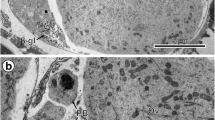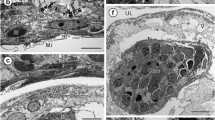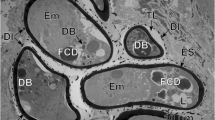Abstract
The fine structure of embryonic envelopes of a linstowiid cestode,Oochoristica anolis, was studied by transmission electron microscopy. Eggs are contained individually within specialized uterine capsules. Despite the added protection of the uterine capsule and modified medullary parenchymal myocytons, each oncosphere is enclosed by the full complement of embryonic envelopes characteristic of most other cyclophyllideans. The embryonic capsule is slightly thickened by deposition of uterine lumenal material on its surface. The syncytial outer envelope contains numerous lipid droplets similar to those of the medullary parenchyma in which the uterine capsules are distributed. Prominent nuclei, mitochondria, ribosomes and glycogen are also present. A bilayered embryophore occupies the distal region of the syncytial inner envelope, which also contains nuclei and numerous ribosomes, but few lipid droplets. One or, more frequently, two oncospheral membranes lie between the inner envelope and oncosphere. These observations suggest that linstowiid embryonic envelopes are formed in a manner similar to those of other cyclophyllideans.
Similar content being viewed by others
References
Coil WH (1975) The histochemistry and fine structure of the embryophore ofShipleya inermis (Cestoda). Z Parasitenkd 48:9–14
Conn DB (1985) Scanning electron microscopy and histochemistry of embryonic envelopes of the porcupine tapeworm,Monoecocestus americanus (Cyclophyllidea: Anoplocephalidae). Can J Zool (in press)
Conn DB, Etges FJ (1984) Fine structure and histochemistry of the parenchyma and uterine egg capsules ofOochoristica anolis (Cestoda: Linstowiidae). Z Parasitenkd 70:769–779
Conn DB, Etges FJ, Sidner RA (1984) Fine structure of the gravid paruterine organ and embryonic envelopes ofMesocestoides lineatus (Cestoda). J Parasitol 70:68–77
Davis RE, Roberts LS (1983) 4. Platyhelminthes — Eucestoda. In: Adiyodi KG, Adiyodi RG (eds) Reproductive biology of invertebrates, Vol. I: Oogenesis, oviposition, and oosorption. John Wiley, New York, p 109
Fairweather I, Threadgold LT (1981)Hymenolepis nana: The fine structure of the embryonic envelopes. Parasitology 82:429–443
Hickman JL (1963) The biology ofOochoristica vacuolata Hickman (Cestoda). Pap Proc R Soc Tasmania 97:81–104
Lethbridge RC (1980) The biology of the oncosphere of cyclophyllidean cestodes. Helminthol Abstr Ser A 49:59–72
Meggitt FJ (1934) On some tapeworms from the bullsnake (Pityopsis sayi), with remarks on the species of the genusOochoristica (Cestoda). J Parasitol 20:181–189
Morseth DJ (1965) Ultrastructure of developing taeniid embryophores and associated structures. Exp Parasitol 16:207–216
Nieland ML (1968) Electron microscope observations on the egg ofTaenia taeniaeformis. J Parasitol 54:957–969
Ogren RE (1957) Morphology and development of oncospheres of the cestodeOochoristica symmetrica Baylis, 1927. J Parasitol 43:505–520
Pence DB (1967) The fine structure and histochemistry of the infective eggs ofDipylidium caninum. J Parasitol 53:1041–1054
Pence DB (1970) Electron microscope and histochemical studies on the eggs ofHymenolepis diminuta. J Parasitol 56:84–97
Rybicka K (1972) Ultrastructure of embryonic envelopes and their differentiation inHymenolepis diminuta (Cestoda). J Parasitol 58:849–863
Staehelin LA (1974) Structure and function of intercellular junctions. Int Rev Cytol 39:191–283
Stunkard HW (1965)Paratriotaenia oedipomidatis gen. et sp. n (Cestoda), from a marmoset. J Parasitol 51:545–551
Swiderski Z (1981) Reproductive and developmental biology of the cestodes. In: Clark Jr WH, Adams TS (eds) Advances in invertebrate reproduction. Elsevier/North Holland, New York, p 365
Ubelaker JE (1983) The morphology, development and evolution of tapeworm larvae. In: Arme C, Pappas PW (ed), Biology of the Eucestoda, Vol. 1. Academic Press, London, p 235
Voge M, Fox W (1950) A new anoplocephalid cestode,Oochoristica scelopori n. sp., from the pacific fence lizard,Sceloporus occidentalis occidentalis. Trans Am Microsc Soc 69:236–242
Wertheim G, Greenberg Z (1971) Helminths of mammals and birds from Israel. II.Sinaiotaenia witenbergi gen. et sp. n (Cestoda: Anoplocephalidae) from desert rodents. Proc Helminthol Soc Wash 38:93–96
Widmer EA, Olsen OW (1967) The life history ofOochoristica osheroffi Meggitt, 1934 (Cyclophyllidea: Anoplocephalidae). J Parasitol 53:343–349
Author information
Authors and Affiliations
Rights and permissions
About this article
Cite this article
Conn, D.B. Fine structure of the embryonic envelopes ofOochoristica anolis (Cestoda: Linstowiidae). Z. Parasitenkd. 71, 639–648 (1985). https://doi.org/10.1007/BF00925597
Accepted:
Issue Date:
DOI: https://doi.org/10.1007/BF00925597




